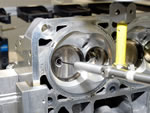Ruthless Pursuit of Power: The Mystique of the C6 Corvette LS7 Engine - Page 25 of 26
Ruthless Pursuit of Power: Lucky Seven Edition: The Mystique of the 7-Liter, 7000-RPM, LS7 - Page 25 of 26
 |
 |
by Hib Halverson
© May 2013— Updated: February 2016
No use without permission, All Rights Reserved
After DeGroff fixed the intake seats, he measured intake and exhaust stem-to-guide clearances and found that the two cylinder heads differed in valve guide diameters by 0003-.0005-in. Apparently, Linamar was incapable of consistently finishing the inside diameters of LS7 valve guides–regardless of their concentricity, or lack thereof–with the seat. This difference had one head with one intake guide at the high limit for production stem clearance and another which was outside production limit, but below the service limit. We were surprised to find that some exhaust valve stem-to-guide clearances on that one new head incrementally exceeded those of both the used heads Bunnin Chevrolet removed. See our measurements page for further details.
Next, Mark DeGroff tested all the valve springs–they were ok–then assembled the heads. We delivered the finished heads to Bunnin Chevrolet the next day and had our car back on the road the following week. After five days of road testing, two-way radio installation work and an exterior graphics application project, in late August, the car was used by the Southern California/Southern Nevada Caravan Organizing Team to lead the 2014 National Corvette Caravan on its 2500-mile journey to the National Corvette Museum at Bowling Green, Kentucky.
There is a compelling "afterword" to this head replacement story. After Bunnin Chevrolet removed the heads from the CAC's Z06, they were returned to GM Powertrain and eventually ended up with Chris Cogan, the Small-Block V8 Design Release Engineer for cylinder heads. Chris put the heads through a couple of sessions in one of the GM Powertrain Inspection Department's Zeiss "Prismo Navigator" Coordinate Measuring Machines (CMM). The Corvette Action Center was present on 24 March 2015, for one of these test sessions. That CMM session proved conclusively that, at the time they were replaced, the heads removed from our car's engine did not have excessively worn valve guides. The guide clearance numbers from the CMM are on our measurement page. The CMM session demonstrated how difficult it is to get accurate stem-to-guide clearance figures with even the best of conventional measuring devices.
The other quality Chris Cogan looked at in the data from the CMM sessions was valve seat run-out. During our measuring session at Mark DeGroff Cylinder Head Service in July of 2014, we measured the seat run out on one of the two heads which were returned to GM after they were replaced under warranty. The CMM measurements of the same head, in some cases were worse—even greater runout—than what we measured with the Goodson valve seat run-out gauge nine-months before.
In July of 2015, with 10,300 miles on the new heads we did the Heads-On test. Guide clearances for 13 valves were below production limits. Three valves were between production and service limits. We have, also, done two more oil analysis with Blackstone Laboratories and the data came back showing reduced copper and iron levels compared to the previous sampling–a good sign. In addition, other wear metals were nominal. Blackstone's report writer commented that a spike in some wear metals was expected due to new parts "wearing in" but did not occur.
LS7 Influences Gen 5
One of the LS7's legacies is how certain of its features, and its development program as a whole, influenced later programs, specifically the 450-horsepower, LT1 and 650-hp LT4, Fifth Generation Small-Block V8s in 2014-2016 Corvette Stingrays and Z06es. We picked a panel of engineers who worked on the LS7: Jordan Lee, John Rydzewski and Mark Damico, all of whom you met earlier, and Yoon Lee, the final LS7 Design System Engineer. We asked for their thoughts on how the LS7 program affected the LT1 project.
Reaching that 500 horsepower goal was a stretch for the team which took LS7 to production. Some of that same type of stretching enabled the Gen 5 Small-Block team to bump the horsepower of the base engine by 20, move specific output just a sliver higher than the LS7's and do that in spite of more stringent fuel economy and exhaust emissions standards. The kind of stretching the Small-Block Team learned during the LS7 program helped the engineers do all that, along with bringing GDI to the Gen 5 and meeting the long-standing engineering challenge of putting cylinder deactivation on engines in Corvettes with manual transmissions.
What LT1 hardware is descended from the LS7? Let's start with dry sump oiling. While dry sumps were eventually used on three different Gen 4 Small Block V8s, the LS7 had it first. All three were PBC engines because, up until the 2014 model year, the dry sump installation didn't lend itself to assembly in automated plants which manufacture the majority of Corvette engines. In the eight years since the C6 Z06's chassis was developed, vehicle dynamics technology has progressed to the point that no Z51, regardless of transmission, can be reliable with a wet sump, so, starting in '14; dry sump oiling is going big time. It will be on all LT1s in Stingrays equipped with Z51 and all C7 Z06es. The vast majority of them will be built at GM's highly-automated, state-of-art, engine plant in Tonawanda, New York which was renovated specifically for Gen 5 V8 production. LT4s destined for Z06es ordered with Z07 will be hand-built at the new Performance Build Center at the Corvette assembly plant in Bowling Green, KY.
 |
 |




